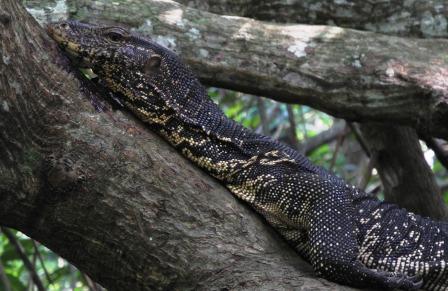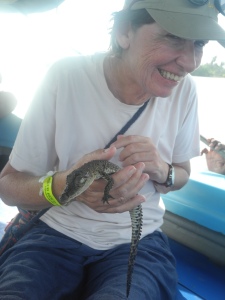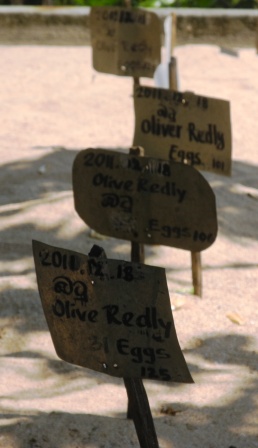Blog Archives
An Albino Turtle in Sri Lanka!
Have you ever seen an albino turtle? Betcha haven’t. We saw two today in totally different and amazing Sri Lanka.
But before I treat you to that vision I’ll fill you in our total day. It was a long fun filled one, so this post will be a bit longer than my last few.
In the morning we visited a mask museum/factory/store. Made from balsa wood and painted with natural colors these traditional masks are still used today to warrant off the spirits of poor health or bring good luck. I bought a couple for future use.

This young man carves the masks. He is a third generation artisan. He really liked my ball cap, but I could not work out a trade with him.

I found this outside the store.This is probably for a charity to buy sacred cows before they get sold to McDonalds. I just loved the wording, so I gave them a few Rupee.
From here we went on a “river safari”. I am going to cheat here and give you some pictures from two different “river safaris” we went on. Sri Lanka has many large rivers, and they all cut through dense jungle, so a visitor gets to see many birds and creatures.

This is a critter I had never heard of before . It is called a Water Monitor. He was about 6 feet long and resembled a giant lizard.

On our second river safari we saw a half dozen of these Water Monitors. This one, in a tree, was keeping a close eye on me while I invaded his space with my Nikon.
We went a ways up river from the ocean into a very large lake. A boy and his monkey came out to greet us and pick up a dollar for getting his picture taken.

He was not happy when I gave him 100 rupee, which is roughly a dollar. I am not sure what the going rate is, but a dollar is a dollar kid. Go feed the monkey.
We went to a buddhist temple in the midle of the lake and actually saw a Bohdi tree.

Buddha received enlightenment while sitting under a Bohdi tree. That exact Bohdi tree is in India. Cuttings from that tree have been replanted at many Buddhist temples. This is one. The tree casts a lot of shade and would make a perfect place to meditate. For a better understanding of Bohdi trees please go http://en.wikipedia.org/wiki/Bodhi_Tree

The monk who guided us around this temple pointed out the the Buddha does not have lines on his hand like you and I, his lines depict lotus flowers. Betcha did not know that! Here is proof!
Another spot in this lake is called Cinnamon Island, for obvious reasons. I read somewhere that Sri Lanka produces something like 90% of the world’s cinnamon.

There are certainly more modern ways to produce cinnamon, but this inhabitant of cinnamon island does it the old way. To make cinnamon sticks, he strips the inner layers of bark from a branch of the tree, then rolls them together. He also made cinnamon powder and cinnamon oil.
We moved on and found a guy in a Sri Lankan cayuco who rowed up to us. I thought he had something to sell, but he just wanted to share his piece of nature with us…

My wife happens to be someone who will cuddle a baby anything. Here she is on River Safari 2 cuddling a month old alligator. The teeth on this little guy were razor sharp. This purveyor of nature got 5 bucks for his efforts!
OK OK already, the albino turtle is coming up!
The only reason seeing an albino turtle was not on my bucket list is because I did not know they existed! Our guide stopped at the Kosgoda Turtle Center to show us the operation there. This is one of four such projects in Sri Lanka. Because they are all located at the beach, they were all wiped out in the tsunami, but have come back, mostly with volunteer labor. If your thing is turtles, you can volunteer there for as long as you like.
Turtle eggs, here and worldwide, are poached by the locals to eat. This practice is the main reason for the drop in turtle population in the world. Turtles have always had to deal with predators, but human overpopulation has made the situation even worse. These projects purchase turtle eggs from the locals for more than they can sell them to restaurants. Then they incubate them.

This is beach sand inside the turtle center where the eggs are incubated until they hatch. The signs denote the type of turtles (there are four in Sri Lanka) and the expected hatch date.

When they hatch they are transferred to a holding pond. They are held for three days. They were so cute that even I cuddled one. At the end of three days they are released back into the ocean at night to deter the bird population from snaring them. The center claims a 50% survival rate for it's turtles, which is considerably higher than the 1% in the wild.
And now for the great finale!

Here he is! He was captured in a fisherman's net and if he had not been an albino would have been eaten. But he was brought to the folks at Kosgoda for us all to enjoy. He lives in his own holding pond. He has been there for many years. When the tsunami hit, the dirctor ran out to the pond, grabbed him, and ran to safety. Aint he cute? There are two of them at Kosgoda.
That’s all for today dear readers. Thanks for being here, tell a friend, make a comment, or go to Sri Lanka to work with turtles!
My next post…up close and personal with BLUE WHALES!

